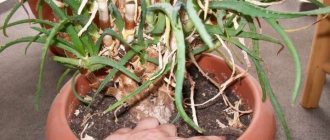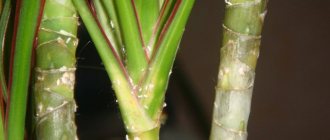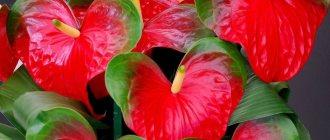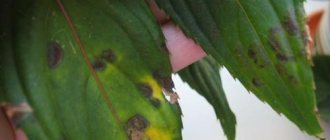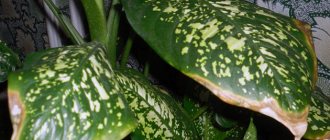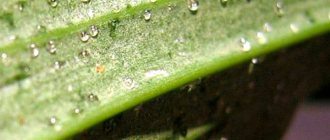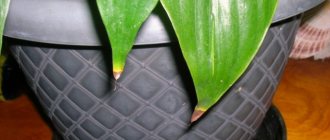Chlorophytum is an evergreen shrub with long saber-shaped leaves.
This flower is very popular among flower growers, as it is absolutely unpretentious and does not require painstaking care.
As a weed, it thrives in both hot and cool conditions. Not afraid of drafts, drought, temperature changes.
Causes of yellowing and drying of leaves of chlorophytum
Almost always, drying and wilting of chlorophytum leaves are a consequence of errors in care:
How to prune Kalanchoe after flowering?
What does the hippeastrum plant look like?
How to grow an orange at home
If the aboveground part of the plant turns pale and then becomes light yellow, it means that the chlorophytum does not have enough lighting or the root system of the flower has grown greatly and the plant does not receive adequate nutrition.
If the lower leaves along their entire length become bright yellow, then the cause may be waterlogging of the soil and, as a consequence, rotting of the root system.
If the tips of the leaves dry out, this indicates insufficient soil moisture or too dry air.
Why do leaf blades turn yellow?
Due to the contrasting color of the leaves of the flower, which is striped with alternating light green and dark green stripes, yellowed and dry areas often remain invisible for a long time. Meanwhile, such a phenomenon indicates that something is wrong with the plant.
Only the ends dry out
This is how the plant signals that the room in which it is located is too hot and dry.
Trying to adapt to unfavorable conditions, the green pet “dries out” the tips of the leaves to reduce the amount of evaporation and preserve precious moisture.
Another common reason is incorrect application of fertilizers and, as a result, oversaturation or lack of necessary microelements.
The powerful root system of chlorophytum very quickly depletes the soil, requiring additional feeding, which leads to the phenomenon of dried leaf tips.
Along the edges
Leaves that dry out around the edges indicate sunburn . Although chlorophytum needs sufficient lighting, placing it in direct sunlight is not recommended.
Standing on a hot windowsill for a long time will cause the leaves to begin to dry out and turn yellow at the edges. If you do not change the location of the plant, the flower will simply die.
If the influence of direct sunlight is excluded, then the reason for the yellowed edges of chlorophytum leaves is the end of the life cycle of this part of the flower.
From below
An alarm signal that the plant sends to its owners. The plant is in unfavorable conditions. Insufficient or excessive watering and lack of lighting are detrimental to the plant .
Another reason is the cramped size of the pot in which it is planted - the root system has become cramped in such a container and needs fresh soil to continue the growing season.
Interesting! According to popular belief, the one who introduces chlorophytum in the house will return lost family happiness. Unmarried girls or single boys will soon be able to find their happiness.
The tips turn black
If you notice dark brown triangles at the tips of chlorophytum leaves, your heating appliances may be working too intensely. The plant consumes moisture not only through the root system, but also with the help of leaves .
Closed, unventilated rooms aggravate the problem, turning elegant leaves into mourning ribbons. When purchasing a plant in a store, some housewives notice dark tips of the leaves on their new flowers.
This may be a consequence of mechanical damage due to careless transportation of the plant. Over-treatment with insecticides against pests has a similar effect.
Why does it turn yellow?
Pests are a common cause of yellowing and even death of chlorophytum. Although the plant is quite unpretentious, the following can settle on it :
- thrips;
- mealybug;
- scale insect;
- spider mite.
Pest activity manifests itself in the form of:
- brownish-yellow growths on leaves (scale);
- cracks (thrips);
- plaque in the form of a microscopic web (spider mite);
- white coating (mealybug).
The flower doesn't grow
Chlorophytum slows down its growth due to improper care. To figure out what exactly the flower “doesn’t like”, it is recommended to check :
- correct watering;
- lighting intensity;
- volume of flower pot;
- soil composition;
- presence of parasites.
Any of these factors can cause slow or no growth.
Ways to solve yellowing of leaves in chlorophytum
Lack of light. This plant loves bright rooms. Usually the flower is placed closer to the windows. If chlorophytum does not have enough light, it immediately begins to lose its green color, its leaves turn yellow and become lethargic.
It is advisable to move the flower pot to a more illuminated place.
In winter, when natural daylight is not enough, use artificial lighting sources;
Lack of nutrition. Chlorophytum needs to be fed throughout the year. In summer, fertilizers are applied frequently, about once a week, in winter less often - once a month;
Cramped pot. "Green Lily" grows quite quickly, especially with careful care. The root system of this flower is quite powerful, so the next time you replant, you need to take the container about 20-30% larger than the previous one in order to provide the roots with enough space to develop.
How to care for chlorophytum at home?
Soil selection
The epiphytic root system will allow the grower not to be tricky with the composition of the soil, but to use a standard mixture. However, the plant will reward you with its beautiful appearance if you make the substrate yourself.
To do this you need to take:
- turf – 3 parts;
- sand (preferably steamed) – 1 part;
- leaf soil (2 parts)
- heat the sand, cool;
- crush the leaf soil;
- mix soil and turf;
- add sand to the mixture and mix well
The soil should be neutral, loose, you can add a little humus.
Selecting a location
An unpretentious bush can thrive in well-lit corridors, near equipment (for example, a computer), and in the kitchen. It should not be placed in drafts, cold window sills or very dry places.
Landing
In order to plant a new plant, you can simply take one of the rosettes, press it to the ground (immediately in the pot) and cover it a little. Nothing else is required, the rosette will take root, putting out new roots, very quickly.
Temperature
The best temperature for summer is from +23 to +27°C. In winter, the temperature can be lowered, the plant will be comfortable at +20°C. At a lower temperature, it is undesirable to torture the flower; it will survive, but will lose its beauty.
Lighting
Of course, chlorophytum can grow in partial shade, but if you place it in the sun, slightly shading it in the hottest time, it will reward you with its beauty. The best lighting for it is a dim, sunny place (for example, an eastern window).
Watering and humidity
For the winter season, very moderate watering (about 2 times a week) is suitable. You can use the weight of the pot as a guide; when it dries, it should become much lighter. In summer, watering follows the usual rules - when the top layer of soil dries out.
Feeding
A standard mineral-organic fertilizer for decorative foliage indoor plants will suit the flower quite well.
Transfer
Spring is the best time to transplant a flower. It is worth choosing a pot according to the size of the plant: a small one may burst under the pressure of powerful roots; too large one will slow down development. When replanting, it is necessary to carefully free the roots from the old soil and, slowly, layer by layer, fill them in a new container with soil prepared in advance.
Watering chlorophytum
The plant prefers constant but moderate moisture. Watering should be done as the soil dries. In summer, 4 times a week, and in winter, depending on the temperature of the plant.
If the temperature does not decrease, then at the same pace. But if the temperature is lower, then you should water several times a week, making sure that there is no stagnation of moisture in the soil.
The plant is unpretentious to indoor air humidity, but it is necessary to spray and take a warm shower once every 30 days. You should not wipe the leaves from dust, since they are quite fragile on the plant.
Overgrown roots
The roots of chlorophytum grow well, fill the container, the plant becomes crowded, it develops poorly, and the leaves begin to turn yellow. When the roots begin to peek out from the drainage holes at the bottom of the container or rise above the soil level, and the leaves turn yellow, transplant into a spacious pot. Young seedlings are replanted once a year in the spring, an adult plant - once every three years. The root system does not go deep, but expands, so the next container should be larger in diameter. Common diseases of chlorophytum leaves.
- In winter, the tips of the leaves may turn black or darken, which means there is excess moisture. Watering should be reduced when the plant is dormant. In winter, the root system is not able to absorb excess moisture and take in nutrients, this leads to rotting of the underground part of the bush. Darkened areas of leaves are trimmed, a constant temperature is maintained, and proper watering is maintained.
- As a result of stagnation of water or waterlogging, the leaf rosette may rot; this problem can occur in tight, heavy soil. The diseased rosette with its root system must be separated and thrown away, and the healthy bush must be moved into loose soil, followed by moderate watering.
- If the plant fades and withers, then there is not enough light in the room and the temperature is too high. The room must be well ventilated, and the plant must be moved to a more illuminated place. Then watering is carried out and fertilizers are applied, gradually the chlorophytum is restored.
- The drying of the lower leaves is considered plant renewal. Old leaves die off and new formations appear; dryness must be trimmed to give a neat appearance to the flower.
Fertilizer for chlorophytum
Chlorophytum can be fed with fertilizer for decorative deciduous plants, organic fertilizers or universal fertilizers (“Rainbow”, “Ideal”). There are a lot of companies producing fertilizers. Go to a flower shop; as a rule, the packages will indicate what plants they can be used for. You can choose granular, executioner (“long-lasting”) and liquid fertilizers.
Chlorophytum transplant
Chlorophytum is replanted every year or two; the best time for this is considered to be February and March. To replant, you need to take a substrate consisting of 1 part leaf soil, one part humus, sand and two parts turf soil. They need to be replanted in spacious flowerpots with good drainage at the bottom. Chlorophytum reproduces by children and division, while the children are simply separated from the peduncle and take root in ordinary soil.
Anthurium male flower: how to care?
Treating apple trees for scab in the fall
Mallow planting seeds in autumn
Reproduction of chlorophytum by lateral shoots
An equally common method for growing chlorophytum at home is the rooting of lateral shoots, the so-called children. This propagation method is simply simple. In addition to beautiful leaves, adult chlorophytum also forms long stems of peduncles, on which daughter rosettes are formed, their appearance resembling the mother plant in “miniature”. This mini bush is ready for planting in the ground immediately after being separated from the stem. But many experienced gardeners recommend first keeping the rosette in a glass of water for several days, and only after the roots become more pronounced, planting them in the ground. The substrate for young plants is prepared in the same way as when dividing a bush. The peculiarity of this method of reproduction is that it is available at any time of the year.
Description and useful properties
Chlorophytum is an evergreen plant with elongated linear leaves collected in basal rosettes. As the flower grows, it forms a lush bush that looks great in group compositions, alone in hanging pots and on stands.
But the main advantage of chlorophytum is not its decorativeness - gardeners love it for its ease of cultivation and its ability to create a useful microclimate around it. Like an ordinary weed, it easily adapts to various conditions: it tolerates heat and coolness well, and is not afraid of temperature changes, drafts, or short-term drought.
Chlorophytum releases a lot of oxygen and special substances - phytoncides, which have the unique property of disinfecting the surrounding space. They neutralize toxic compounds - tobacco smoke, carbon monoxide, volatile formaldehyde emitted by plastic coatings and furniture.
Important! The appearance of the plant does not depend on the presence of harmful volatile impurities in the air, since it feeds on them. The main reason for yellowing leaves is errors in care.
Diseases and pests of chlorophytum
Chlorophytum can be affected by thrips (see photo above). To prevent the appearance and spread of this pest, it is necessary to maintain a sufficiently high air humidity around the plant and periodically inspect it.
If pests do appear, you need to cut off the affected leaves, dilute the insecticide against aphids according to the instructions, treat the plant, and then repeat the treatment four more times with an interval of 8 days. To prevent these pests from appearing, place several mothballs near the chlorophytum; the smell will repel thrips.
